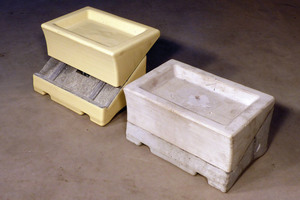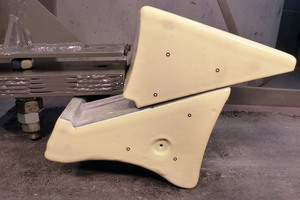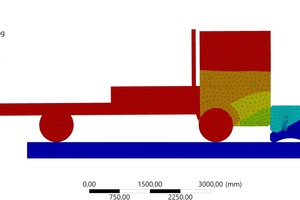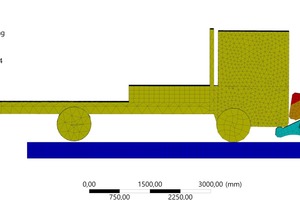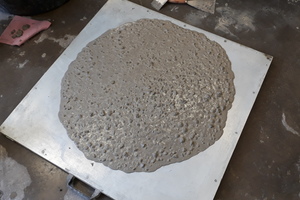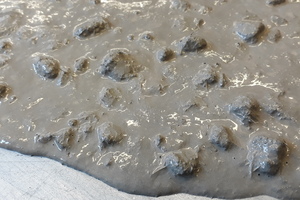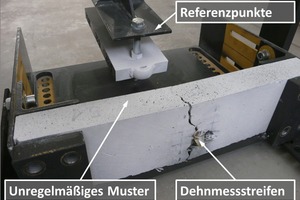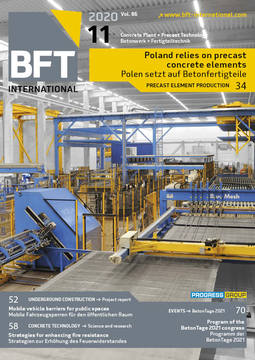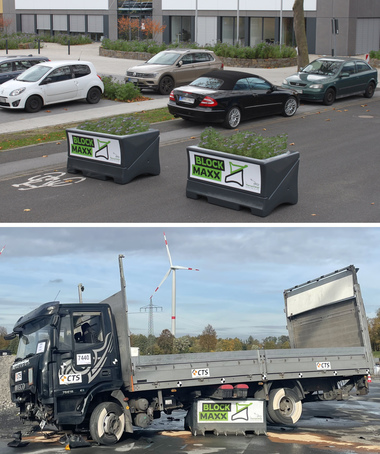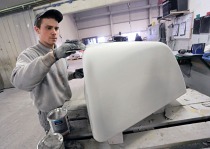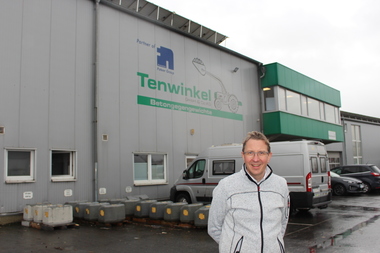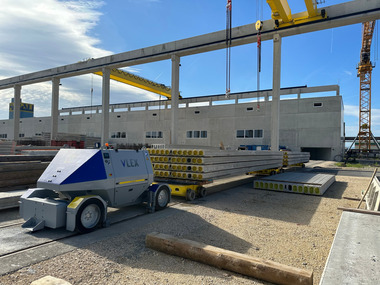BLOCKMAXX – mobile vehicle barrier for public spaces
“Träume brauchen Sicherheit” (“Dreams Need Security”) was once the advertising claim of a big German insurance company appealing to one of the most fundamental human needs. When it comes to security, people clearly prefer building with concrete. In a joint project, Tenwinkel GmbH & Co. KG and IAB Weimar gGmbH successfully transferred and commercialized the results of their research on a mobile vehicle barrier BLOCKMAXX, made from heavyweight concrete.
“Dreams Need Security” was once the advertising claim of a big German insurance company appealing to one of the most fundamental human needs. When it comes to security, people clearly prefer building with concrete, which is a straightforward, no-frills material that easily resists exceedingly high loads while providing a high degree of flexibility and structural stability. In a joint project, Tenwinkel GmbH & Co. KG and IAB Weimar gGmbH successfully transferred and commercialized the results of their research on a mobile vehicle barrier BLOCKMAXX made from heavyweight concrete.
The peaceful picture of populated streets and squares has undergone major changes as a result of the growing number of increasingly severe terrorist attacks. Anyone can be hit anywhere, including deaths and injuries, which is why urban security is becoming a key topic of the future in order to prevent attacks such as those in August 2016 on the beach promenade in Nice or in December 2016 at Breitscheidplatz in Berlin, where the attackers drove vehicles into crowds of people.
Security precautions for events held in public spaces vary across the individual federal states of Germany. They range from waiving all precautions in some places to erecting fortress-like structures in others, depending on the number of pedestrians frequenting the respective space. Stationary protective structures are often not practicable, which is why mobile vehicle barriers are increasingly being used. For the most part, the currently available barrier systems appear to be exceedingly obtrusive and may thus indeed deter potential attackers. Yet, such barrier systems create increased uneasiness among visitors and observers.
In view of this situation, Tenwinkel GmbH & Co. KG and IAB Weimar gGmbH joined forces to develop an innovative mobile vehicle barrier providing protection against the unauthorized ingress of motor vehicles of different sizes. At the same time, the new vehicle barrier should be aesthetically appealing to visitors and event hosts while being as unobtrusive as possible in order not to disrupt the overall appearance of the urban space.
Stability
The mobile vehicle barrier has to withstand highly dynamic loads when impacted by a motor vehicle. This is why resistance testing is one of the most important steps in verifying the suitability of the construction material.
The development of the concrete recipe aimed to achieve the highest bulk density possible while ensuring a high compressive and flexural strength with a concurrent low dynamic modulus of elasticity. Its workability characteristics were aligned with those of self-compacting concrete; the aim was to keep its setting time short while providing high early strength after 24 hours. The selected input materials were restricted to cements, superplasticizers and aggregates (magnetite) already available at the production facility, plus additional rock powders and silica fume. Short steel fibers were added in order to produce a high-strength heavyweight concrete exhibiting self-compacting properties without sedimentation, thus achieving performance characteristics perfectly suited to the intended use.
A specially designed drop hammer test rig was used to implement a comprehensive testing program with the aim of verifying the performance of concrete specimens produced according to various recipes. Two-dimensional imaging provided the basis for a detailed characterization of the deformation behavior in the presence of high impact impulses.
Under highly dynamic loading, the fiber-reinforced specimens exhibited a significantly retarded fatigue behavior compared to their unreinforced counterparts. More specifically, adding short stainless-steel fibers resulted in a highly ductile material, thus preventing sudden failure and countering the uncontrolled detachment of isolated concrete fragments.
Function
The results of the resistance tests created the basis for subsequent functional testing. These tests essentially involved numerical simulations aiming to create a better functional understanding in order to identify the most appropriate functioning mechanism of the vehicle barrier. For this purpose, different scenarios were compared to each other, and the most promising design and functional approach was selected for further refinement.
A compact cuboid design was chosen for the vehicle barrier (with a total weight of about 3.7 metric tons) composed of a lower and an upper part. When impacted by a vehicle, the inclined sliding surface guides the barrier’s upper part, which moves both forwards and upwards in the direction of impact. A specially designed coupling element concealed in the cuboid’s interior limits the end stop when the barrier is pushed up and defines its open shape in which the barrier unfolds its full effectiveness. Two scenarios are assumed depending on the type of vehicle:
Scenario 1:
The vehicle barrier wedges itself in front of and under the vehicle. Its tipping movement increases the friction between the ground and the barrier and decelerates the vehicle in a controlled manner.
Scenario 2:
The tipping movement of the vehicle barrier thrusts the vehicle front vertically upwards, and a large portion of the kinetic energy is transformed into the vehicle’s vertical movement. The vehicle front then crashes onto the tipped-over barrier and the remaining kinetic energy is dissipated through the friction between the ground and the barrier.
In either of these scenarios, the engine block and vehicle steering system will be damaged so severely due to the impact’s immobilizing action. The vehicle is braked in a controlled manner.
Design
Many different factors influence the functionality of a vehicle barrier. This is why practical trials and verifications are costly and time-consuming. The finite-element method provides a much more rapid and effective alternative for the preliminary design of complex functional mechanisms. This method is based on dynamic simulations and was applied for the purpose of calculating and analyzing the most appropriate way of pushing up the components of the barrier, which was considered to be a fundamental prerequisite for achieving the envisaged immobilizing effect.
The simulation results proved the influence of the angle of the sliding area between the lower and the upper part on the barrier’s push-up behavior. This angle not only determines the final height of the pushed-up element but also the length of the horizontal lever that wedges itself under the vehicle. In addition, it influences the friction between the lower and the upper part that counteracts the push-up movement.
Another important functional aspect identified in the simulations was the weight ratio of 1.5 to 1.0 between the lower and the upper part, which was proven to be the most appropriate. If a lower ratio is chosen, the immobilizing element will not be pushed up properly. The weight ratio can also be influenced by the volume of the lower and the upper part. However, the more flexible option is to increase the lower part’s density by using heavyweight concrete while retaining its shape entirely.
Laboratory specimens
Several laboratory specimens were produced for preliminary practical trials. This work greatly benefited from the extensive experience of Tenwinkel GmbH & Co. KG in the fields of mold-making and pouring concrete ballast weights because the tailor-made design of the vehicle barrier required a sophisticated, innovative formwork system. For this purpose, a 3D CAD model was scaled down, and a plastic model of both the lower and the upper part was printed. These models serve as templates for the final, high-quality negative molds made from silicone that allow for non-destructive demolding and multiple use cycles.
The lower part was produced from heavyweight concrete while the upper part consisted of normal concrete in order to correctly represent the original mass relationship on a laboratory scale. A polyurea coating was applied in order to investigate its preventive action against fragmentation and the increase in friction forces acting in contact with the ground. The drop hammer test rig was adapted mechanically in order to perform functional tests on the laboratory specimens for the purpose of validating the simulation results.
Outlook
After the production of the original-size sample barriers, they were subjected to a comprehensive testing program involving different impact angles in order to demonstrate their performance in two crash tests for certification purposes carried out in accordance with the technical guideline on mobile vehicle barriers and the ISO IWA 14-1:2013 standard. “We consider the positive outcomes of the simulations and laboratory tests to be a promising indicator of the barriers being really fit for their intended purpose,” comments Markus Tenwinkel, who is very optimistic regarding the successful commercialization of the new BLOCKMAXX and its envisaged production in correspondingly large numbers.
Summary
The experience of the past few years highlights a decrease in urban security and demonstrates why people no longer feel comfortable in public spaces. “More than ever, it is all about strengthening both the actual and perceived level of security by developing structured, well-thought-out designs and implementing effective measures in order to protect public spaces from vehicle attacks. This is why it is so important to invest in security and to provide tailor-made solutions to visitors and users amid the increasingly fierce debate,” adds project manager Maximilian Ettel.
The newly developed BLOCKMAXX provides an effective protective system whose unobtrusive formal language paves the way for a security culture that is omnipresent in an urban setting. As a result, the general public will again perceive urban spaces as safe and secure places of communication while the genius loci can be preserved almost completely.

